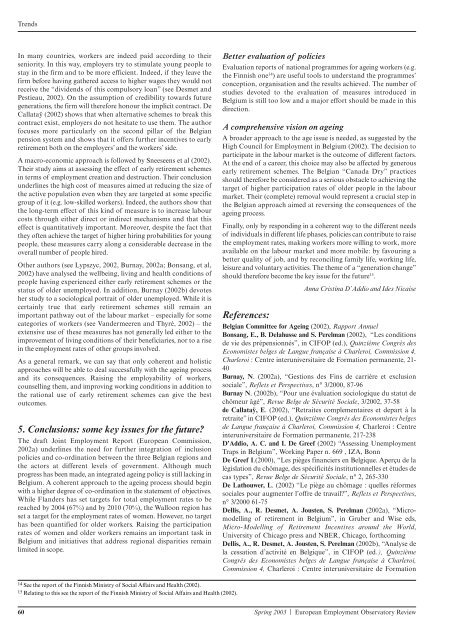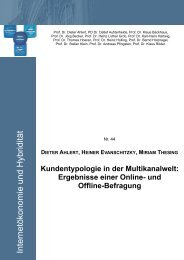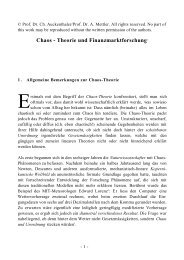FRANCE The
FRANCE The
FRANCE The
Create successful ePaper yourself
Turn your PDF publications into a flip-book with our unique Google optimized e-Paper software.
Trends<br />
In many countries, workers are indeed paid according to their<br />
seniority. In this way, employers try to stimulate young people to<br />
stay in the firm and to be more efficient. Indeed, if they leave the<br />
firm before having gathered access to higher wages they would not<br />
receive the “dividends of this compulsory loan” (see Desmet and<br />
Pestieau, 2002). On the assumption of credibility towards future<br />
generations, the firm will therefore honour the implicit contract. De<br />
Callataÿ (2002) shows that when alternative schemes to break this<br />
contract exist, employers do not hesitate to use them. <strong>The</strong> author<br />
focuses more particularly on the second pillar of the Belgian<br />
pension system and shows that it offers further incentives to early<br />
retirement both on the employers’ and the workers’ side.<br />
A macro-economic approach is followed by Sneeseens et al (2002).<br />
<strong>The</strong>ir study aims at assessing the effect of early retirement schemes<br />
in terms of employment creation and destruction. <strong>The</strong>ir conclusion<br />
underlines the high cost of measures aimed at reducing the size of<br />
the active population even when they are targeted at some specific<br />
group of it (e.g. low-skilled workers). Indeed, the authors show that<br />
the long-term effect of this kind of measure is to increase labour<br />
costs through either direct or indirect mechanisms and that this<br />
effect is quantitatively important. Moreover, despite the fact that<br />
they often achieve the target of higher hiring probabilities for young<br />
people, these measures carry along a considerable decrease in the<br />
overall number of people hired.<br />
Other authors (see Lypszyc, 2002, Burnay, 2002a; Bonsang, et al,<br />
2002) have analysed the wellbeing, living and health conditions of<br />
people having experienced either early retirement schemes or the<br />
status of older unemployed. In addition, Burnay (2002b) devotes<br />
her study to a sociological portrait of older unemployed. While it is<br />
certainly true that early retirement schemes still remain an<br />
important pathway out of the labour market – especially for some<br />
categories of workers (see Vandermeeren and Thyré, 2002) – the<br />
extensive use of these measures has not generally led either to the<br />
improvement of living conditions of their beneficiaries, nor to a rise<br />
in the employment rates of other groups involved.<br />
As a general remark, we can say that only coherent and holistic<br />
approaches will be able to deal successfully with the ageing process<br />
and its consequences. Raising the employability of workers,<br />
counselling them, and improving working conditions in addition to<br />
the rational use of early retirement schemes can give the best<br />
outcomes.<br />
5. Conclusions: some key issues for the future?<br />
<strong>The</strong> draft Joint Employment Report (European Commission,<br />
2002a) underlines the need for further integration of inclusion<br />
policies and co-ordination between the three Belgian regions and<br />
the actors at different levels of government. Although much<br />
progress has been made, an integrated ageing policy is still lacking in<br />
Belgium. A coherent approach to the ageing process should begin<br />
with a higher degree of co-ordination in the statement of objectives.<br />
While Flanders has set targets for total employment rates to be<br />
reached by 2004 (67%) and by 2010 (70%), the Walloon region has<br />
set a target for the employment rates of women. However, no target<br />
has been quantified for older workers. Raising the participation<br />
rates of women and older workers remains an important task in<br />
Belgium and initiatives that address regional disparities remain<br />
limited in scope.<br />
14 See the report of the Finnish Ministry of Social Affairs and Health (2002).<br />
15 Relating to this see the report of the Finnish Ministry of Social Affairs and Health (2002).<br />
Better evaluation of policies<br />
Evaluation reports of national programmes for ageing workers (e.g.<br />
the Finnish one14 ) are useful tools to understand the programmes’<br />
conception, organisation and the results achieved. <strong>The</strong> number of<br />
studies devoted to the evaluation of measures introduced in<br />
Belgium is still too low and a major effort should be made in this<br />
direction.<br />
A comprehensive vision on ageing<br />
A broader approach to the age issue is needed, as suggested by the<br />
High Council for Employment in Belgium (2002). <strong>The</strong> decision to<br />
participate in the labour market is the outcome of different factors.<br />
At the end of a career, this choice may also be affected by generous<br />
early retirement schemes. <strong>The</strong> Belgian “Canada Dry” practices<br />
should therefore be considered as a serious obstacle to achieving the<br />
target of higher participation rates of older people in the labour<br />
market. <strong>The</strong>ir (complete) removal would represent a crucial step in<br />
the Belgian approach aimed at reversing the consequences of the<br />
ageing process.<br />
Finally, only by responding in a coherent way to the different needs<br />
of individuals in different life phases, policies can contribute to raise<br />
the employment rates, making workers more willing to work, more<br />
available on the labour market and more mobile: by favouring a<br />
better quality of job, and by reconciling family life, working life,<br />
leisure and voluntary activities. <strong>The</strong> theme of a “generation change”<br />
should therefore become the key issue for the future15 .<br />
Anna Cristina D’Addio and Ides Nicaise<br />
References:<br />
Belgian Committee for Ageing (2002), Rapport Annuel<br />
Bonsang, E., B. Delahusse and S. Perelman (2002), “Les conditions<br />
de vie des prépensionnés”, in CIFOP (ed.), Quinzième Congrès des<br />
Economistes belges de Langue française à Charleroi, Commission 4,<br />
Charleroi : Centre interuniversitaire de Formation permanente, 21-<br />
40<br />
Burnay, N. (2002a), “Gestions des Fins de carrière et exclusion<br />
sociale”, Reflets et Perspectives, n°3/2000, 87-96<br />
Burnay N. (2002b), “Pour une évaluation sociologique du statut de<br />
chômeur âgé”, Revue Belge de Sécurité Sociale, 3/2002, 37-58<br />
de Callataÿ, E. (2002), “Retraites complementaires et depart à la<br />
retraite” in CIFOP (ed.), Quinzième Congrès des Economistes belges<br />
de Langue française à Charleroi, Commission 4, Charleroi : Centre<br />
interuniversitaire de Formation permanente, 217-238<br />
D’Addio, A. C. and I. De Greef (2002) “Assessing Unemployment<br />
Traps in Belgium”, Working Paper n. 669 , IZA, Bonn<br />
De Greef I.(2000), “Les pièges financiers en Belgique. Aperçu de la<br />
législation du chômage, des spécificités institutionnelles et études de<br />
cas types”, Revue Belge de Sécurité Sociale, n°2,265-330<br />
De Lathouwer, L. (2002) “Le piège au chômage : quelles réformes<br />
sociales pour augmenter l’offre de travail?”, Reflets et Perspectives,<br />
n° 3/2000 61-75<br />
Dellis, A., R. Desmet, A. Jousten, S. Perelman (2002a), “Micromodelling<br />
of retirement in Belgium”, in Gruber and Wise eds,<br />
Micro-Modelling of Retirement Incentives around the World,<br />
University of Chicago press and NBER, Chicago, forthcoming<br />
Dellis, A., R. Desmet, A. Jousten, S. Perelman (2002b), “Analyse de<br />
la cessation d’activité en Belgique”, in CIFOP (ed.), Quinzième<br />
Congrès des Economistes belges de Langue française à Charleroi,<br />
Commission 4, Charleroi : Centre interuniversitaire de Formation<br />
60 Spring 2003 | European Employment Observatory Review

















